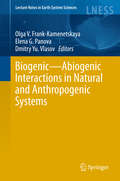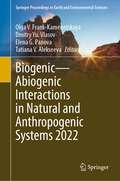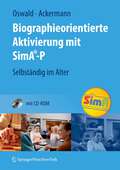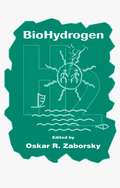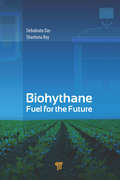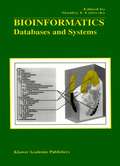- Table View
- List View
Biogenesis Evolution Homeostasis: A Symposium by Correspondence
by Alfred LockerIn 1963, 1965 and 1967 "Symposia on Quantitative Biology of Metabolism" were organized on the pretty island of Helgoland (Biologische Anstalt) by me in col laboration with O. KINNE and F. KROGER. Unfortunately this worthy approach towards bringing together interested scholars in a regular way ceased, mainly for financial reasons, although the need for and interest in conferences like these for the exchange of ideas on special topics unchangeably persists. So I had to look for other possibilities and one of them was to try to arrange a similar con ference under the auspices of NASA. This institution, however, eventually re-. treated, although during my discussion with its representatives a new special theme gained shape. This is the topic to which this volume is devoted: Bio genesis. It is also treated in a new way that probably could be a model for. similar undertakings: a symposium by correspondence. In this new approach to scientific information exchange, manuscripts were collected by the editor and sent to every contributor for his comments. The author could then reply by means of a concluding remark. So, in many instances very valuable ideas concerning the topics of the several papers could be gathered and it is to be hoped that this procedure has conferred upon this volume a certain uniqueness. Of course, I had to observe the agreement with Springer-Verlag not to exceed the extent of the volume allotted to us.
The Biogenesis of Cellular Organelles (Molecular Biology Intelligence Unit)
by Chris MullinsThe Biogenesis of Cellular Organelles represents a comprehensive summary of recent advances in the study of the biogenesis and functional dynamics of the major organelles operating in the eukaryotic cell. This book begins by placing the study of organelle biogenesis in a historical perspective by describing past scientific strategies, theories, and findings and relating these foundations to current investigations. Reviews of protein and lipid mediators important for organelle biogenesis are then presented, and are followed by summaries focused on the endoplasmic reticulum, Golgi, lysosome, nucleus, mitochondria, and peroxisome.
Biogenic—Abiogenic Interactions in Natural and Anthropogenic Systems: Abiogenic Interactions In Natural And Anthropogenic Systems (Lecture Notes in Earth System Sciences)
by Olga V. Frank-Kamenetskaya Elena G. Panova Dmitry Yu. VlasovThis book offers a collection of papers presented at the V International Symposium "Biogenic - abiogenic interactions in natural and anthropogenic systems" that was held from 20-22 October 2014 in Saint Petersburg (Russia). Papers in this book cover a wide range of topics connected with interactions between biogenic and abiogenic components in the lithosphere, biosphere and technosphere. The main topics include: biomineralization in geosystems, geochemistry of biogenic-abiogenic systems, biomineral interactions in soil, minerals in living organisms and biomimetic materials, medical geology, bioweathering and destruction of cultural heritage.
Biogenic—Abiogenic Interactions in Natural and Anthropogenic Systems 2022 (Springer Proceedings in Earth and Environmental Sciences)
by Olga V. Frank-Kamenetskaya Dmitry Yu. Vlasov Elena G. Panova Tatiana V. AlekseevaThe book represents a collection of papers presented at VII International Symposium "Biogenic-abiogenic interactions in natural and anthropogenic systems" that was held on 26-29 September 2022 in Saint Petersburg (Russia). Papers in this book cover a wide range of topics connecting with interactions between biogenic and abiogenic components in lithosphere, biosphere and technosphere. The main regarding topics are following: biomineralization in living organisms and nature-like materials; biomineralization in geosystems; geochemistry of biogenic-abiogenic systems; biomineral interactions in soil; interaction of microorganisms with natural and artificial materials; medical geology; philosophical aspects of interdisciplinary researchs
Biogeogens and Human Health (SpringerBriefs in Public Health)
by Niraj KumarHealth of the people is the most important indicator of the development of a nation. Health is a state of complete physical, mental and social well being and not merely the absence of disease or infirmity (as defined by WHO). The state of health of an individual or population depends upon complex interaction of the physical, biological, political and social domains. The environment affects the human health in a big way. People tend to be most susceptible to illness when physically or mentally stressed. Stress, energy and immunity form a closely knit network. Through his experimental findings, the author has brought out this intricate concept of interdependence of biotic (living) and abiotic (non-living) factors in an ecosystem, resulting in an impact on human health, in an explicitly marvelous manner. As a result, a new word “Biogeogens” has been coined, “bio” for living (biotic) , “geo” for non-living (abiotic/geographical/climatic/environment) and “gens” for the interactive proceeds of the two. The content included herein is directly concerned with the societal health and gives a clue to many socio-psycho health problems presently not handled with care. It also defines a multidimensional approach for dealing with many psychosomatic and health problems.
Biografiearbeit: in der Gesundheits-, Kranken- und Altenpflege
by Monika Specht-TomannBiografiearbeit als ein Instrument in der Kranken- und Altenpflege schärft den Blick für die Bedürfnisse von Patienten. Auf diese Art und Weise werden die Ressourcen von Patienten für deren Gesundung genutzt, alte Menschen werden aktiviert und damit ihre Lebensqualität verbessert. In dem Band erläutert die Autorin verschiedene Methoden der Biografiearbeit und bietet Schritt-für-Schritt-Anleitungen für deren Umsetzung. In der 2., überarbeiteten Auflage geht sie ausführlicher auf spezielle Patientengruppen wie u. a. demenzkranke Menschen ein.
Biografiearbeit: in der Gesundheits-, Kranken- und Altenpflege
by Monika Specht-TomannBiografiearbeit ist ein Instrument in der Kranken- und Altenpflege, mit dem der Blick für das Leben der Patienten bzw. der Bewohner geschärft und der ganzheitliche Zugang zu ihren Bedürfnissen erleichtert wird. Fähigkeiten von Alten und Kranken werden durch Biografiearbeit aktiviert und verbessert. Das Buch ist mit zahlreichen Anleitungen zur Umsetzung der verschiedenen Methoden und mit vielen Beispielen aus der Pflege- und Betreuungspraxis eine Unterstützung für alle, die mit alten und kranken Menschen arbeiten.
Biografiearbeit: in der Gesundheits-, Kranken- und Altenpflege
by Monika Specht-TomannBiografiearbeit als ein Instrument in der Kranken- und Altenpflege schärft den Blick für die Bedürfnisse von Patienten. Auf diese Art und Weise werden die Ressourcen von Patienten für deren Gesundung genutzt, alte Menschen werden aktiviert und damit ihre Lebensqualität verbessert. In dem Band erläutert die Autorin verschiedene Methoden der Biografiearbeit und bietet Schritt-für-Schritt-Anleitungen für deren Umsetzung. In der 2., überarbeiteten Auflage geht sie ausführlicher auf spezielle Patientengruppen wie u. a. demenzkranke Menschen ein.
Biographical History of Behavioral Neuroendocrinology
by Randy J. Nelson Zachary M. WeilBehavioral neuroendocrinologists are interested in the interactions between hormones and behaviors. This unique book tracks the development of behavioral neuroendocrinology from the first recognized paper in the field by Arnold Berthold in 1849 to the major contributors of the past century. It traces the history and development of the field by exploring the women and men who conducted the studies that revealed these hormone-behavioral relationships. Most chapters are written by the individuals who knew these pioneers best, and describe their stories and discuss the ways in which their work has shaped the field. Now is the perfect time for this book. The field is burgeoning and interest in the development of theoretical perspectives is thriving. Moreover, although this field was dominated by men early on, it has become a field with near sexual parity among its faculty, society membership, and leadership, and thus serves as an example of equitable science, training, and advocacy.
Biographieorientierte Aktivierung mit SimA-P: Selbständig im Alter
by Wolf-D. Oswald Andreas AckermannWenn alte Menschen über ihre Erinnerungen sprechen, kann das dem Verlust von Identität und Selbstwissen entgegenwirken. Der praxiserprobte Leitfaden zur biographieorientierten Aktivierung stellt neben einem kurzen allgemeinen Teil insgesamt 28 Therapieeinheiten vor. Ablaufpläne und Arbeitsmaterialien für die Gruppenarbeit erleichtern die Umsetzung. Die mitgelieferte CD-ROM enthält Kopiervorlagen. Der Band richtet sich an alle Personen, die beruflich oder ehrenamtlich im Bereich der Alltagshilfe tätig sind.
BioHydrogen
by Oskar R. ZaborskyThe world needs clean and renewable energy and hydrogen represents an almost ideal resource. Hydrogen is the simplest and most abundant molecule in the universe, yet one that is a challenge to produce from renewable resources. Biohydrogen, or hydrogen produced from renewable resources such as water or organic wastes by biological means, is a goal worthy of increased global attention and resources. The purpose of BioHydrogen '97 was to bring together leaders in the biological p- duction of hydrogen from the United States, Japan, Europe, and elsewhere to exchange scientific and technical information and catalyze further cooperative programs. Parti- pants came from at least different countries representing academia, industry, and g- ernment. Especially important participants were young research scientists and engineers: the next generation of contributors. The conference consisted of plenary presentations, topical sessions, posters, and mini-workshop discussions on key areas of biohydrogen. It was designed to maximize - formation exchange, personal interaction among participants, and formulate new inter- tional initiatives. BioHydrogen '97 was an outgrowth of an international workshop convened by the Research Institute of Innovative Technology for the Earth (RITE) and was held in Tokyo, Japan, November 24-25, 1994. The RITE workshop was highly successful but largely l- ited to traditional biochemical and biological studies and not engineering research topics.
Biohydrogen Production: Fundamentals and Technology Advances
by Debabrata Das Namita Khanna Chitralekha Nag DasguptaBiohydrogen Production: Fundamentals and Technology Advances covers the fundamentals of biohydrogen production technology, including microbiology, biochemistry, feedstock requirements, and molecular biology of the biological hydrogen production processes. It also gives insight into scale-up problems and limitations. In addition, the book discusses
Biohythane: Fuel for the Future
by Debabrata Das Shantonu RoyThis book is a novel attempt at describing the fundamental aspects of and advancements in the field of biohythane production. The comprehensive collection of chapters is based on the fundamentals of heterotrophic hydrogen production and consequent methane production technologies. Emphasis is on the integration of two stages of a hybrid system for maximum gaseous energy generation from organic wastes, thus making the overall process economically viable. Readers get insight into the technological advancements made in the field of biohydrogen and biomethane production and the challenges involved in integrating these two technologies. The book also includes details of the microbiological, biochemical, and bioprocess aspects related to biohythane production, in addition to the applicability of this process, its socioeconomic concerns, and cost energy analysis, supplemented with illustrative diagrams, flowcharts, and comprehensive tables. It will be an ideal vade mecum for advanced undergraduate- and graduate-level students of biotechnology, microbiology, biochemical engineering, chemical engineering, and energy engineering; teachers and researchers in bioenergy, the environment, and biofuel production; and policy makers.
Biohythane: Fuel for the Future
by Debabrata Das Shantonu RoyThis book is a novel attempt at describing the fundamental aspects of and advancements in the field of biohythane production. The comprehensive collection of chapters is based on the fundamentals of heterotrophic hydrogen production and consequent methane production technologies. Emphasis is on the integration of two stages of a hybrid system for maximum gaseous energy generation from organic wastes, thus making the overall process economically viable. Readers get insight into the technological advancements made in the field of biohydrogen and biomethane production and the challenges involved in integrating these two technologies. The book also includes details of the microbiological, biochemical, and bioprocess aspects related to biohythane production, in addition to the applicability of this process, its socioeconomic concerns, and cost energy analysis, supplemented with illustrative diagrams, flowcharts, and comprehensive tables. It will be an ideal vade mecum for advanced undergraduate- and graduate-level students of biotechnology, microbiology, biochemical engineering, chemical engineering, and energy engineering; teachers and researchers in bioenergy, the environment, and biofuel production; and policy makers.
Bioimage Data Analysis Workflows (Learning Materials in Biosciences)
by Kota Miura Nataša SladojeThis Open Access textbook provides students and researchers in the life sciences with essential practical information on how to quantitatively analyze data images. It refrains from focusing on theory, and instead uses practical examples and step-by step protocols to familiarize readers with the most commonly used image processing and analysis platforms such as ImageJ, MatLab and Python. Besides gaining knowhow on algorithm usage, readers will learn how to create an analysis pipeline by scripting language; these skills are important in order to document reproducible image analysis workflows. The textbook is chiefly intended for advanced undergraduates in the life sciences and biomedicine without a theoretical background in data analysis, as well as for postdocs, staff scientists and faculty members who need to perform regular quantitative analyses of microscopy images.
Bioimaging in Neurodegeneration (Contemporary Neuroscience)
by Patricia A. Broderick David N. Rahni Edwin H. KolodnyBioimaging is in the forefront of medicine for the diagnosis and helps to predict the progression of AD via mild cognitive treatment of neurodegenerative disease. Conventional magnetic impairment (MCI) studies. resonance imaging (MRI) uses interactive external magnetic fields Novel neuroimaging technologies, such as neuromolecular and resonant frequencies of protons from water molecules. imaging (NMI) with a series of newly developed BRODERICK ® However, newer sequences, such as magnetization-prepared rapid PROBE sensors, directly image neurotransmitters, precursors, acquisition gradient echo (MPRAGE), are able to seek higher and metabolites in vivo, in real time and within seconds, at separate levels of anatomic resolution by allowing more rapid temporal and selective waveform potentials. NMI, which uses an imaging. Magnetic resonance spectroscopy (MRS) images electrochemical basis for detection, enables the differentiation of metabolic changes, enabling underlying pathophysiologic neurodegenerative diseases in patients who present with mesial dysfunction in neurodegeneration to be deciphered. Neuro- versus neocortical temporal lobe epilepsy. In fact, NMI has some 1 chemicals visible with proton H MRS include N-acetyl aspartate remarkable similarities to MRI insofar as there is technological (NAA), creatine/phosphocreatine (Cr), and choline (Cho); NAA dependence on electron and proton transfer, respectively, and is considered to act as an in vivo marker for neuronal loss and/or further dependence is seen in both NMI and MRI on tissue neuronal dysfunction. By extending imaging to the study of composition such as lipids.
Bioimpedance in Biomedical Applications and Research
by Franco Simini Pedro Bertemes-FilhoThis book is based on the best contributions to the advancement of bioimpedance knowledge and use from the Latin American Congress series, CLABIO. Basic bioimpedance facts as well as promising and original contributions to bioimpedance theory and applications are presented, giving the reader stimulating material for reflection, decision making, and further experiments. Contributions come from a diverse international pool of experts and address topics on electrode and skin impedance modelling, tomography, spectroscopy, instrumentation, and clinical applications.
Bioinformatic and Statistical Analysis of Microbiome Data: From Raw Sequences to Advanced Modeling with QIIME 2 and R
by Jun Sun Yinglin XiaThis unique book addresses the bioinformatic and statistical modelling and also the analysis of microbiome data using cutting-edge QIIME 2 and R software. It covers core analysis topics in both bioinformatics and statistics, which provides a complete workflow for microbiome data analysis: from raw sequencing reads to community analysis and statistical hypothesis testing. It includes real-world data from the authors’ research and from the public domain, and discusses the implementation of QIIME 2 and R for data analysis step-by-step. The data as well as QIIME 2 and R computer programs are publicly available, allowing readers to replicate the model development and data analysis presented in each chapter so that these new methods can be readily applied in their own research. Bioinformatic and Statistical Analysis of Microbiome Data is an ideal book for advanced graduate students and researchers in the clinical, biomedical, agricultural, and environmental fields, as well as those studying bioinformatics, statistics, and big data analysis.
Bioinformatics: A Practical Guide to the Analysis of Genes and Proteins (Methods of Biochemical Analysis #43)
by Andreas D. Baxevanis B. F. Ouellette"In this book, Andy Baxevanis and Francis Ouellette . . . have undertaken the difficult task of organizing the knowledge in this field in a logical progression and presenting it in a digestible form. And they have done an excellent job. This fine text will make a major impact on biological research and, in turn, on progress in biomedicine. We are all in their debt." —Eric Lander from the Foreword Reviews from the First Edition "...provides a broad overview of the basic tools for sequence analysis ... For biologists approaching this subject for the first time, it will be a very useful handbook to keep on the shelf after the first reading, close to the computer." —Nature Structural Biology "...should be in the personal library of any biologist who uses the Internet for the analysis of DNA and protein sequence data." —Science "...a wonderful primer designed to navigate the novice through the intricacies of in scripto analysis ... The accomplished gene searcher will also find this book a useful addition to their library ... an excellent reference to the principles of bioinformatics." —Trends in Biochemical Sciences This new edition of the highly successful Bioinformatics: A Practical Guide to the Analysis of Genes and Proteins provides a sound foundation of basic concepts, with practical discussions and comparisons of both computational tools and databases relevant to biological research. Equipping biologists with the modern tools necessary to solve practical problems in sequence data analysis, the Second Edition covers the broad spectrum of topics in bioinformatics, ranging from Internet concepts to predictive algorithms used on sequence, structure, and expression data. With chapters written by experts in the field, this up-to-date reference thoroughly covers vital concepts and is appropriate for both the novice and the experienced practitioner. Written in clear, simple language, the book is accessible to users without an advanced mathematical or computer science background. This new edition includes: All new end-of-chapter Web resources, bibliographies, and problem sets Accompanying Web site containing the answers to the problems, as well as links to relevant Web resources New coverage of comparative genomics, large-scale genome analysis, sequence assembly, and expressed sequence tags A glossary of commonly used terms in bioinformatics and genomics Bioinformatics: A Practical Guide to the Analysis of Genes and Proteins, Second Edition is essential reading for researchers, instructors, and students of all levels in molecular biology and bioinformatics, as well as for investigators involved in genomics, positional cloning, clinical research, and computational biology.
Bioinformatics: Managing Scientific Data (The Morgan Kaufmann Series in Multimedia Information and Systems)
by Terence Critchlow Zoé LacroixLife science data integration and interoperability is one of the most challenging problems facing bioinformatics today. In the current age of the life sciences, investigators have to interpret many types of information from a variety of sources: lab instruments, public databases, gene expression profiles, raw sequence traces, single nucleotide polymorphisms, chemical screening data, proteomic data, putative metabolic pathway models, and many others. Unfortunately, scientists are not currently able to easily identify and access this information because of the variety of semantics, interfaces, and data formats used by the underlying data sources. Bioinformatics: Managing Scientific Data tackles this challenge head-on by discussing the current approaches and variety of systems available to help bioinformaticians with this increasingly complex issue. The heart of the book lies in the collaboration efforts of eight distinct bioinformatics teams that describe their own unique approaches to data integration and interoperability. Each system receives its own chapter where the lead contributors provide precious insight into the specific problems being addressed by the system, why the particular architecture was chosen, and details on the system's strengths and weaknesses. In closing, the editors provide important criteria for evaluating these systems that bioinformatics professionals will find valuable.* Provides a clear overview of the state-of-the-art in data integration and interoperability in genomics, highlighting a variety of systems and giving insight into the strengths and weaknesses of their different approaches. * Discusses shared vocabulary, design issues, complexity of use cases, and the difficulties of transferring existing data management approaches to bioinformatics systems, which serves to connect computer and life scientists. * Written by the primary contributors of eight reputable bioinformatics systems in academia and industry including: BioKris, TAMBIS, K2, GeneExpress, P/FDM, MBM, SDSC, SRS, and DiscoveryLink.
Bioinformatics: A Practical Guide to NCBI Databases and Sequence Alignments (Chapman & Hall/CRC Computational Biology Series)
by Hamid D. IsmailBioinformatics: A Practical Guide to NCBI Databases and Sequence Alignments provides the basics of bioinformatics and in-depth coverage of NCBI databases, sequence alignment, and NCBI Sequence Local Alignment Search Tool (BLAST). As bioinformatics has become essential for life sciences, the book has been written specifically to address the need of a large audience including undergraduates, graduates, researchers, healthcare professionals, and bioinformatics professors who need to use the NCBI databases, retrieve data from them, and use BLAST to find evolutionarily related sequences, sequence annotation, construction of phylogenetic tree, and the conservative domain of a protein, to name just a few. Technical details of alignment algorithms are explained with a minimum use of mathematical formulas and with graphical illustrations. Key Features Provides readers with the most-used bioinformatics knowledge of bioinformatics databases and alignments including both theory and application via illustrations and worked examples. Discusses the use of Windows Command Prompt, Linux shell, R, and Python for both Entrez databases and BLAST. The companion website contains tutorials, R and Python codes, instructor materials including slides, exercises, and problems for students. This is the ideal textbook for bioinformatics courses taken by students of life sciences and for researchers wishing to develop their knowledge of bioinformatics to facilitate their own research.
Bioinformatics: A Practical Guide to NCBI Databases and Sequence Alignments (Chapman & Hall/CRC Computational Biology Series)
by Hamid D. IsmailBioinformatics: A Practical Guide to NCBI Databases and Sequence Alignments provides the basics of bioinformatics and in-depth coverage of NCBI databases, sequence alignment, and NCBI Sequence Local Alignment Search Tool (BLAST). As bioinformatics has become essential for life sciences, the book has been written specifically to address the need of a large audience including undergraduates, graduates, researchers, healthcare professionals, and bioinformatics professors who need to use the NCBI databases, retrieve data from them, and use BLAST to find evolutionarily related sequences, sequence annotation, construction of phylogenetic tree, and the conservative domain of a protein, to name just a few. Technical details of alignment algorithms are explained with a minimum use of mathematical formulas and with graphical illustrations. Key Features Provides readers with the most-used bioinformatics knowledge of bioinformatics databases and alignments including both theory and application via illustrations and worked examples. Discusses the use of Windows Command Prompt, Linux shell, R, and Python for both Entrez databases and BLAST. The companion website contains tutorials, R and Python codes, instructor materials including slides, exercises, and problems for students. This is the ideal textbook for bioinformatics courses taken by students of life sciences and for researchers wishing to develop their knowledge of bioinformatics to facilitate their own research.
Bioinformatics: Volume I: Data, Sequence Analysis and Evolution (Methods in Molecular Biology #452)
by Jonathan M. Keith and John WalkerIn this book, leading researchers in the field of Bioinformatics provide a selection of the most useful and widely applicable methods, able to be applied as is, or with minor variations, to many specific problems. Over 80 authors from around the globe contribute to the two volumes, including many leading experts in their respective subjects. They encompass topics from across the diverse field of bioinformatics through its broad scope, combining to provide an inter-disciplinary collaboration involving biologists, biochemists, physicists, mathematicians, statisticians and computer scientists.
Bioinformatics: Volume II: Structure, Function and Applications (Methods in Molecular Biology #453)
by Jonathan M. KeithIn Bioinformatics, leading researchers provide a selection of the most useful and widely applicable methods, able to be applied as is, or with minor variations, to many specific problems. Volume II: Structure, Function and Applications contains methods pertinent to the prediction of protein and RNA structures and the analysis and classification of structures, methods for inferring the function of previously identified genomic elements, chiefly protein-coding genes, medical applications in diagnostics and drug discovery, and "meta-methods" for developers of bioinformatics algorithms. Over 80 authors from around the globe have contributed to the two volumes.
Bioinformatics: Databases and Systems
by Stanley LetovskyBioinformatics brings computational methods to the analysis and processing of genomic data. Bioinformatics: Databases and Systems focuses on the issues of system building and data curation that dominate the day-to-day concerns of bioinformatics practitioners. Included are chapters by many of today's leading bioinformatics practitioners, describing most of the current paradigms of system building and curation, including both their strengths and weaknesses. Biological topics covered include sequence databases, metabolic pathways, phenotypes, variety collections, gene expression atlases and neuroinformatics. Species range from bacteria to mammals to plants. Software systems and technologies covered include OPM, CORBA, SRS, KLEISLI, ACEDB, Web-based integration and laboratory workflow. Bioinformatics: Databases and Systems provides a valuable introduction for newcomers to the field, and a useful reference for veterans.


